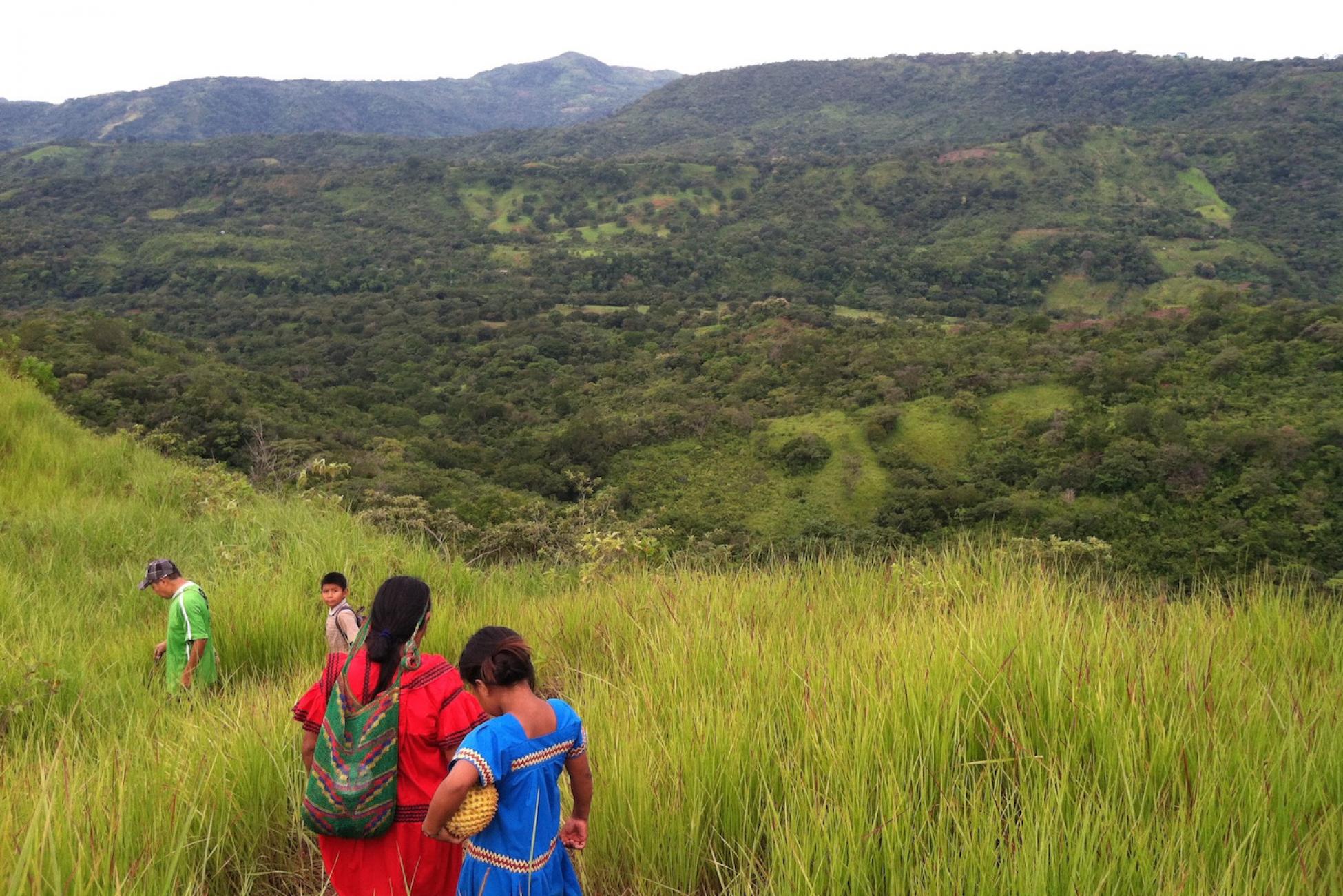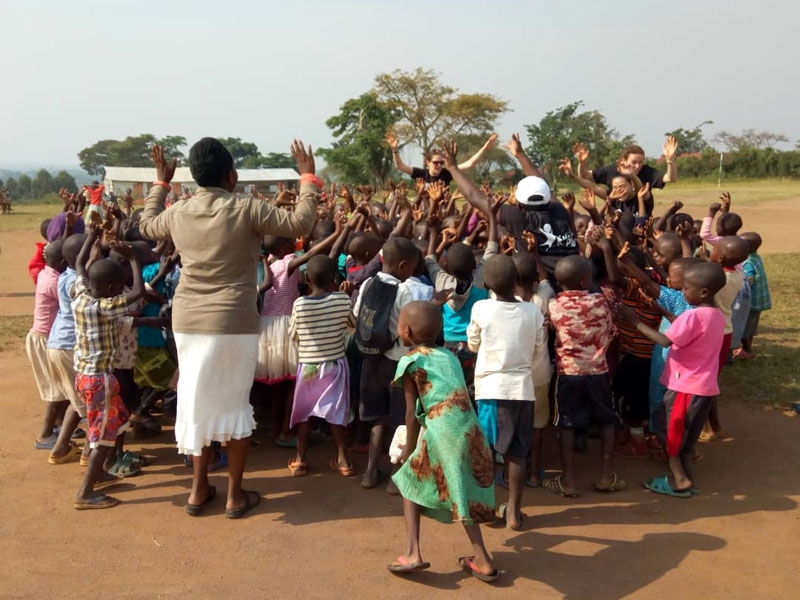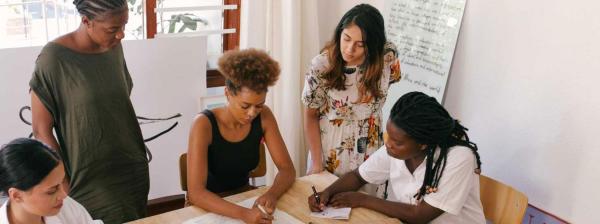We climb a widening road of orange jagged earth, cracked with deep crevices. The back and forth of farmers’ boots have impressed steep stairs in the dirt. Isidro’s eyes illuminate as we approach new trees, fruits and grasses along the path. He names each one; first in Spanish, and then in Ngäbere, his native language.
I’d only known Isidro and his wife, Maria, for minutes when they invited me to see their second property; a house two hours by foot from the town of Soloy in Panama’s Ngöbe-Bugle Comarca region. As a new volunteer in their community, I welcomed the opportunity to hike beyond the mountainous town where I was teaching.
Maria manages the trek in her ankle-length nahua dress and knock-off Crocs. Isidro carries a blunt machete as a walking stick. Two eight-year-olds trail behind: the couple’s grandson and the daughter of the Ngöbe woman who has been hosting me. As we walk, Isidro dreams aloud about his visions for the undeveloped land: a tourist lookout and a fruit stand selling picnic provisions from the trees he nurtures himself.
Compared to this mountainside escape, tiny Soloy—where teenagers crowd around a radio for entertainment—seems bustling. But here in the mountains, not even Maria’s grandson causes an interruption. He climbs an avocado tree. A blue butterfly perches itself on the toe of his shoe. No one makes a sound.
On our return, Isidro resumes his role as nature guide. He unwraps a galleta, a butter-flavoured shortbread that costs 25 cents in town. I watch him toss the plastic wrapping over a fence. It blows away, tumbling down rows of rice. I wonder how someone can throw trash into the same field where he’d invited me to feel the soft grasses of new rice plants just an hour earlier.
I say nothing, afraid to criticize. Yet, in my silence, I feel complicit in the act.
Like many travellers who are accustomed to placing garbage in public trash cans and setting recycling on the curb, I was left dumbfounded by the garbage-strewn streets that I encountered in rural Panama. But as I discovered, solving waste problems isn’t as simple as a quick clean-up tutorial. For many communities, littering isn’t an issue of ignorance—it’s a problem rooted in economics and policy.
Searching for viable solutions
My first week volunteering in Soloy, I was offered a ride to Cruce, a neighbouring town, by a man with a pickup truck. He had pointed out the window. “Tenemos tierra, pero no tenemos plata,” he said. (“We have land, but no money.”) Rich green velvet coated the Comarca; rolling peaks overflowing with palm and lime trees. But my eyes were glued to the cans and wrappers that speckled the roadside. For volunteers locked in a North American mindset, scattered garbage can seem like an insult to communities so rich with natural beauty.
For volunteers locked in a North American mindset, scattered garbage can seem like an insult to communities so rich with natural beauty.
Juan Carlos Bejerano, an ecotourism guide from Soloy, felt similarly stumped by the garbage in his community. According to Bejerano, it’s still a new issue in Soloy. Two generations ago, the Ngöbe-Bugle people used banana leaves and other plant parts to wrap and serve food; all waste would decompose naturally. Today, the same paved roads that reduce travel time to hospitals and carry teachers to the primary schools are a path of packaging. Plastic soda bottles, tin beer cans, and foil snack wrappers fall from children’s hands and are launched from bus windows throughout town.
Not far from Cruce in Panama’s Bocas del Toro islands, Sean Murphy encountered similar distractions. While researching poison dart frogs at the Smithsonian Tropical Research Institute, she found this trash problem—which invaded the waterways—impossible to ignore. “I felt weird that we were studying this paradise while the environment was clearly declining,” she says.
Murphy teamed up with Erica Staaterman, vice-president of the oceanic research non-profit, Beneath the Waves. With a team of researchers, they embarked on a documentary film project to address the pollution on the Bocas islands. Their interviews with locals, tourists, and the town mayor revealed a clear root cause; a lack of resources to pay for removal.
Nearly 80 per cent of people in Latin America and the Caribbean live in cities; fittingly, Panama’s largest landfill, Cerro Patacón, is just outside of the capital. But rural areas with lower population densities, like those in the Comarca or the Bocas islands, are often left on the back-burner. Shipping trash from isolated communities—specifically islands or mountains—requires transport: boats, trucks, and buses, and the hired people to operate them and carry waste to processing plants sometimes hundreds of miles away.
“The resources aren’t necessarily available for them to dispose of trash,” says Emily Talentino, executive director of Give and Surf, a non-profit that works with Ngöbe in Bocas del Toro. “What are they supposed to do if they put all of their trash in a bag and there’s no town pick-up?”
The Isla Colón Airport’s slight three-dollar tourist tax—implemented to address pollution left by tourists and locals alike—is not covering Bocas’ clean-up costs. And although a system now exists for locals to pay a small trash pick-up fee, most opt to burn their waste illegally.
“Right now there isn’t accountability,” says Murphy. Garbage pickup is a mix between private and public and isn’t funded properly. People don’t pay for the service, so no one arrives to remove trash. And tourists leave the islands confused—where is their three-dollar clean-up fee going if the islands still appear to overflow with garbage?
Bejerano and his team of eco tour guides are working to establish accountability on a smaller scale. The guides speak with individuals and families, encouraging them to carry their trash home and evaluate the damage on a single-household basis. He himself refuses to purchase products packaged in aluminum or tin; but in a developing and growing community, plastic seems unavoidable. Leaving trash on the ground, he stresses, only hurts the community and the entire planet as a whole. Soloy’s wealth lies in its natural beauty—waterfalls, mountains and rivers that leave his clients awestruck—and he wants to protect and keep it clean for locals and tourists alike.
“I started to see it as an economic problem, not just an environmental problem.”
Staaterman shared this viewpoint, primarily concerned with respect for nature. But with further research, she says, “I started to see it as an economic problem, not just an environmental problem.”
Staaterman and Murphy aim to complete their documentary, Paradise Trashed, and screen it in Bocas to present viable answers—an increased tourist tax and a recyclable bottle tax—and invite the town to vote. The film will dive into the complexities of a solution, from sourcing the label for the bottles, to a Panama-wide waste management initiative.
Staaterman hopes that screening the documentary in Bocas and sharing it online will allow it to serve as a model for other small communities, and even small countries. Change, she argues, only comes about if you present easy, tangible solutions.
Sharing perspectives
While I felt overwhelmed by the trash in Soloy, I was too nervous as a solo volunteer to offend anyone. I hesitated to criticize a community that was not mine. A kind man had invited me to hike through the mountains, eat arroz nuevo with his family, and teach me about his culture. Did I have the audacity to challenge his behaviour over one tiny piece of plastic?
I chose to collect and dispose of my own trash in the nearest city, while leaving everyone else’s on the ground. I’d come to teach, I told myself—not to pick-up after other people.
But by ignoring the issue, was I not part of the problem?
Talentino believes that instead of criticizing or ignoring the issue altogether, the path to a realistic solution begins with engagement. Volunteers can respect a community’s challenges by simply asking members for their perspective.
While Bejerano would appreciate help from authorities and nonprofits, he hopes to find a solution among his people on a local scale. From evaluating the types of waste produced on an individual household basis, community members could invent new uses for these non-biodegradable materials, he suggests. Maybe they could produce artisan goods from plastic wrappers and aluminum cans, and then sell their creations for a profit. In the meantime, waiting for a trash collection system to develop may not have to be the only answer.
“It comes down to knowing the culture to know what issues are facing a community before you visit,” says Talentino. “Once you know those issues, you can be respectful and be part of the solution, not part of the problem.”
This article originally appeared in the Spring 2017 issue of Verge.
Add this article to your reading list




